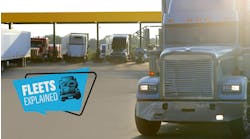The key to cutting NOx emissions in a diesel engine’s cylinder without increasing the amount of particulate matter (PM) generated is to raise fuel injection pressures greatly at engine speeds as low as 800 rpm, according to Tim Shick, Navistar director of business and product strategy.
It has been generally accepted that raising the amount of exhaust gas recirculation (EGR) will lower NOx creation by lowering combustion temperatures within the cylinder, but increase PM or soot emissions because it would also leave large amounts of fuel unburned.
Navistar’s non-SCR approach to the next level of emissions requirements will boost injection pressures to around 35,000 psi, Shick said during a recent briefing for the Penton Transportation Group. “But you can’t just raise the pressure,” he said. “You have to get it at low speeds where the engine is loaded with fuel that may not burn and creates soot.” Higher injection pressure increases the surface area of the fuel, leading to a more efficient burn that prevents PM from forming.
Multiple injection events at those low speeds and high pressure rates – as many as five in a single combustion stroke – also create a smoother combustion event that helps further retard NOx generation, according to Shick. “If you don’t let NOx form in the cylinder, you don’t need SCR to remove it from the exhaust stream,” he said.
Other key elements in Navistar’s 2010 emissions strategy include modifying turbocharger rates, optimizing combustion with a redesigned piston bowl and careful calibration of electronic engine controls.
The company will not certify engines at the 0.2 gram NOx level required for 2010, but rather use emissions credits generated by high volumes of light- and medium-duty diesel engine sales over the past years to gradually move to that level over the next two years. Although its EGR-only approach can already meet the 0.2 level, Navistar wants to adjust its engine calibrations in steps to avoid fuel-economy and performance penalties, Shick indicated.
Navistar is “the only company generating enough credits to handle a phase-in like this,” Shick said. Dialing in its electric engine calibration over that period “will let us get the performance customers want without giving up fuel economy,” he said. Even with the credits in place, Navistar engines will have NOx emissions well below current levels when the new standards take effect on Jan. 1, 2010, he added.
See also: Navistar banking on EGR for 2010

